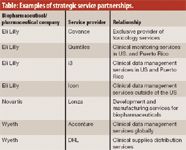Strategic Service Partnerships Gain Momentum
Dire circumstances are driving major drug companies to seek out CRO partners. This article contains bonus online-exclusive material.
With financial support for emerging companies down and major pharmaceutical firms pruning back their development pipelines, 2009 hasn't started auspiciously for contract service providers. One bright spot is the growing trend among major pharmaceutical companies to outsource a greater portion of their development activities to contract research organizations (CROs).

Jim Miller
A particularly striking element of this outsourcing trend is the willingness of some major biopharmaceutical and pharmaceutical firms to give up their entire capability in one functional area and depend solely on a CRO partner. These are not just redundant or nuisance activities: they include mission-critical activities necessary for business operations and regulatory approval and compliance. These new pharma company–CRO relationships, which we have termed "strategic service partnerships," often involve the sale of one or more facilities and transfer of all of the pharmaceutical company's technical staff to the CRO.
This practice first appeared several years ago when Wyeth (Madison, NJ) outsourced its clinical data management capability to Accenture. It also gained a great deal of attention in the summer of 2008 when Eli Lilly and Company (Indianapolis) made Covance (Princeton, NJ) its sole provider of toxicology capabilities. The most recent example came in January of this year when Merck (Whitehouse Station, NJ) made PPD (Wilmington, NC) its single source of testing and assay development capabilities for its vaccine development program. PPD agreed to purchase Merck's 130,000-ft2 laboratory in Wayne, Pennsylvania, and hired the 80 Merck employees that staff the laboratory.
Delivering performance
Driving these strategic service partnerships is the realization by major pharmaceutical companies that CROs can deliver certain activities cheaper, faster, and better than their in-house operations. Part of that performance advantage stems from the fact that the client pays only for the share of the facility's capacity it is actually using, rather than absorbing the total cost of staffing and operating the laboratory. Additional value comes from the CROs who realize that their success depends on delivering better performance, and gearing their processes and metrics to meet that objective.

Table: Examples of strategic service partnerships.
Another feature of these partnerships is the close cooperation they entail between the client and the service provider. Typically, the pharma company already has extensive experience with the supplier, knows and appreciates its abilities, and is comfortable entrusting it with a critical function. The partners in these deals, however, often move beyond that experience to improve the processes involved in the relationship. They work together to identify cost drivers, for example, and restructure processes in an effort to reduce resources employed in the activity.
First efforts
Other industries such as information technology have been taking advantage of these types of partnerships for more than 25 years. Based on their experiences, we can expect the model to be refined over time. Some of the deals, for instance, include take-or-pay elements that commit the client to a minimum level of expenditure. These provisions protect the CRO's downside, but negate some of the cost and risk-mitigation advantages that would otherwise accrue to the pharmaceutical or biopharmaceutical company. Future deals may leave out such take-or-pay provisions or make them less onerous. We also expect future deals to be more global in scope (many current partnerships focus on providing regional services).
We also expect strategic service partnerships to move into new activities in the development value chain, especially in the areas of clinical pharmacology, analytical chemistry, and clinical packaging. There are very competent contract providers in these areas and current captive capacity is probably underused.
In their public presentations, many CRO executives claim to be in discussions with multiple clients about establishing more strategic service partnerships. These opportunities will be open only to the largest CROs, those that have deep capabilities and experience as well as a strong balance sheet. If they are to serve the major drug companies, smaller CROs will need to find unique niches that complement the capabilities of their larger competitors.
Jim Miller is president of PharmSource Information Services, Inc., and publisher of Bio/Pharmaceutical Outsourcing Report, tel. 703.383.4903, fax 703.383.4905, info@pharmsource.com, www.pharmsource.com.
